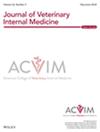The Effect of Season and Breed on Hypothalamic–Pituitary–Adrenal Axis Hormones, Metabolic Hormones, and Oxidative Markers in Ponies and Horses
Abstract
Background
Endocrine function in ponies differs from horses, with seasonally increased concentrations of plasma adrenocorticotropic hormone (ACTH) and an increased risk of insulin dysregulation.
Hypothesis
(1) Season and breed differences exist in concentrations of hypothalamic–pituitary–adrenal axis and metabolic hormones; and (2) systemic oxidative status is significantly different between ponies and horses and correlates with endocrine hormones.
Animals
Thirty-four healthy Welsh ponies and 14 healthy Quarter horses.
Methods
Blood was collected from Welsh ponies and Quarter horses in the same region during the same weeks in May and October. Concentrations of plasma ACTH, insulin, leptin, derivatives of reactive oxygen metabolites (dROMs), plasma antioxidant capacity (PAC), and serum total cortisol, percent-free cortisol, and estimated free cortisol concentrations were measured. Linear mixed effects modeling with a random effect for animal was used to determine the effects of season and breed. Correlation coefficients were calculated for relevant variables. Statistical significance was set at p < 0.05.
Results
Fall plasma ACTH concentration was significantly higher in ponies compared with horses (p < 0.001). Total cortisol concentration was significantly lower in ponies in fall compared with spring (p = 0.05; 95% confidence interval [CI] = 0.005–0.934). Insulin concentrations in ponies were significantly higher in fall compared with spring (p < 0.001) and compared with horses in fall (p < 0.001). In horses, PAC was higher in fall than in spring (p = 0.01; 95% CI = −730.2T to −99.26). Correlations varied with season and breed.
Conclusions
Season and breed significantly affect the HPA axis, metabolic hormones, and oxidative status. Our results support breed consideration when interpreting endocrine testing results in horses.


 求助内容:
求助内容: 应助结果提醒方式:
应助结果提醒方式:


